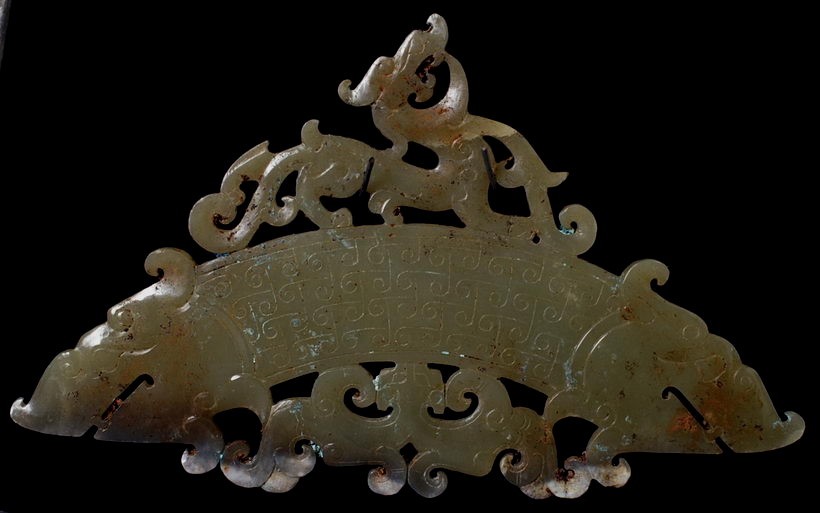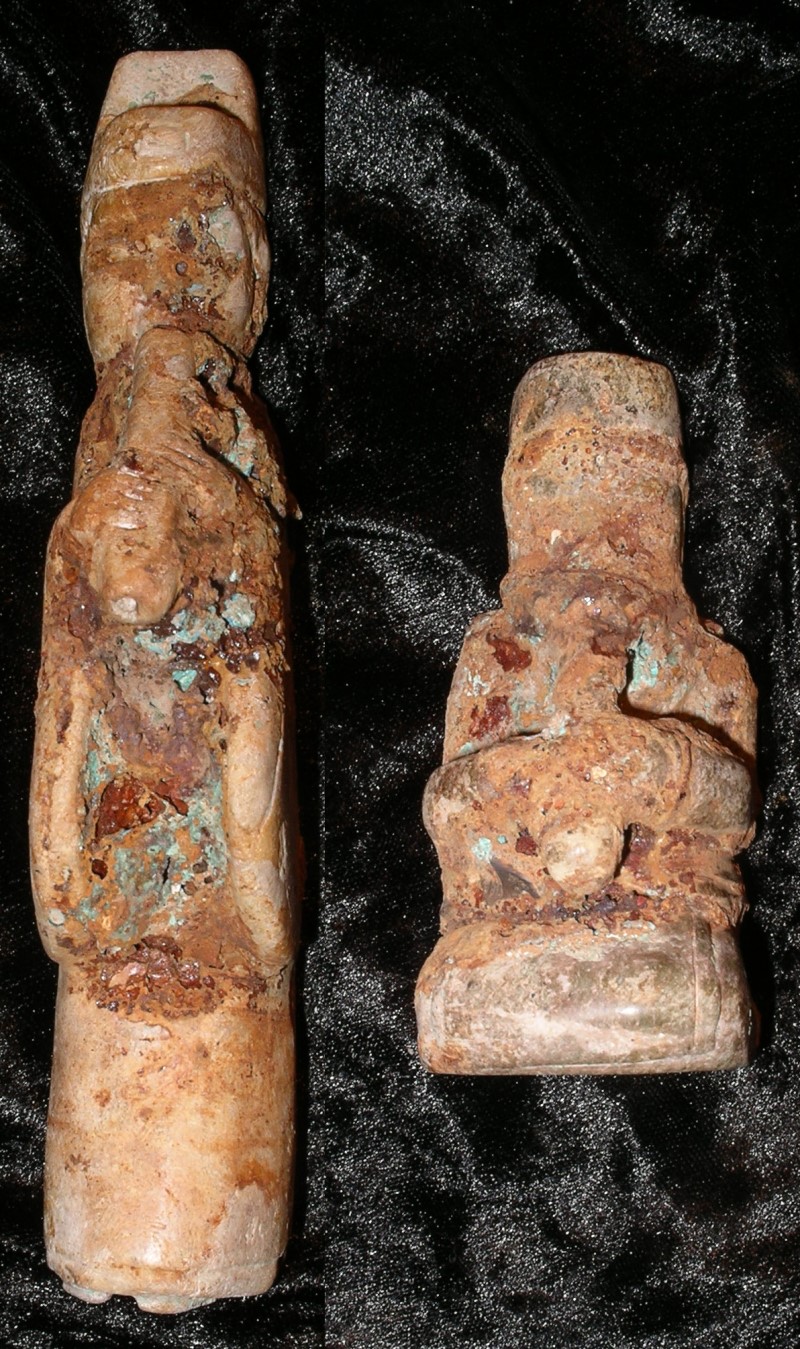
(Rhetorical question, of course it can not be assessed only by an image)
Without a demonstration and explanation saying a jade is faked or completely new, although a change in the surface of the jade is present, is thoughtless and unprofessional!
Do not take such remarks serious to spoil your joy of collecting this wonderful art works of Chinese culture!
Many collectors of beautiful jades are confused by such thoughtless remarks. Here are some tips for your decision support to acquire old Jades!
Questions about authenticity and age of Jades:
Basically: If Jades are beautiful and perfect, you CANNOT determine the age!
The only criteria would determine costs, cutting technique and style, yet possibly the material. But all this can be almost perfectly copyed!
Jades that have changed mineralogically because of long soil storage, it is different! Here at least you might have the evidence of chemical / mineralogical investigation to determin the authenticity of jade. There is NO 100 % sureness at present time!!!
Here it shows already, that a calcinated or contaminated Jade can be art-historically far more valuable than a flawless, beautiful glossy worked jade.
What does the calcination or contamination of a jade mean?
Note: To prevent a quibble: The calcination of the speech is here, is NOT a "flower pot" calcination occuring on longer used flower pots, these layers can be removed easily and are certainly not a feature of age.
The calcination / contamination referred to here is a mineralogical and color change of the Jadestructure which is not only superficial but goes into the depth of the material. It arises during a long period of time by chemical reaction with soil minerals, acids, plant roots and objects of the graves in which many Jades were placed. This contamination could be very different in color and mineralogical composition and is very difficult to forge, although some "Experts" think this is possible, or consider it as very simple.
On what may we consider to look for?
Here one should pay attention to the variety of colors and variety of contamination of the jade - the more different colors and mineralogically change, the safer you can be that it is an old jade. A chemical-mineralogical investigation could bring certainty, also the use of a up-light microscope with appropriate experience has given good results. Investigation can be difficult if a new manufactured Jade is made of old weathered Jade. Here it requires some experience to recognize whether it is a new or old work!
Further surface conditions
To achieve a more respectable and shiny appearance of old Jade, these are worked by most unqualified Chinese people more or less professionally, cleaned with modern equipment and abrasives and finally waxed.
This, of course, will left modern machining and grinding marks on the jade surface, and this result can be quickly interpreted by untrained persons and so-called "Experts" as a forgery for the whole Jade. But often remain at a contaminated Jade, which was cleaned this way, enough old authentication features, which are then, for whatever reasons, are ignored. The Jade is out of ignorance simply classified as a total fake and too often without providing conclusive evidence for this claim!
 |
||
|
Example of contaminated and untreated Jades which may be cleaned once. This cleaning will surely leave traces of modern editing and grinding tracks!
|
||
Further consideration:
The amount of work compared to the price-performance ratio. It should be noted that jadeite and nephrite can also be finished with modern equipment only with great effort very difficult.
Let us once the workflow in mind: First of all, must be made an elaborately carved jade. Then the jade work would have to be artificially aged, which again represents a heavy workload due to the chemicals in use could be dangerous for the health. Manufacturers and counterfeiters (faker) of course can be different people. But that does not change the overall situation. We're talking about the price difference of a beautiful jade, which is getting a bit unsightly Jade! Here we may think about the question: What is easier to sell?
What does the expression mean "feeling" of jade?
To answer this question one should first illuminate all the terms Jade, from Spanish (yjada) and Yu, from Chinese. In short, both terms include a variety of minerals. We will consider here only the two minerals are commonly known as Jade, the Jadeite and the Nephrite. These two names are two very different minerals which have completely different mineralogic structures, but are referred collectively as commonly use JADE.
Short info on Mineralogy:
Jadeite is a sodium aluminum silicate and belongs to the pyroxene group. Hardness of about 6-7, depending on quality, mineral structure fine-rough-armorph.
Nephrite is a hydrous calcium ferro-magnesium silicate, and belongs to the amphibole group, depending on the quality, hardness about 6 to 6.5, mineral structure, fine-structured which explains the high toughness of the mineral.
Was hat das nun mit dem Ertasten von Jade zu tun? Bei den Chinesen steht der Nephrit und Jadeit in der Wertigkeit am höchsten und da viele ähnlich aussehende Mineralien z.B. Serpentinit u.a. optisch sehr schwer von diesen von einander zu unterscheiden sind, haben es einige Chinesen und inzwischen auch andere Personen gelernt das unterschiedliche Mineralgefüge von anderen Steinen durch betasten zu unterscheiden. So können sie bis zu einem gewissen Grad erkennen was echter Nephrit-Jadeit ist und was nicht.
What does this have to do with the "feeling" of Jade? Among the Chinese, is the Nephrite and Jadeite in the highest quality and because many similar-looking minerals such as Serpentinite e.g. optically very difficult to distinguish from each of these, there have been some Chinese and other people learned the different mineral structure of other stones to distinguish by "feeling". That know they can, to some degree, notice by feeling what is real jade, Jadeite and what is not.
Damit ist die Zielsetzung klar: Durch intensives betasten möchte man festzustellen was echter Nephrit-Jadeit (yu-zhenyu) ist und was nicht! Hier kann es bei Jadearbeiten schon zu Irritationen über echt oder falsch kommen, wenn das Ziel der Betastung nicht klar definiert ist!
Kann man nun durch betasten feststellen ob eine Nephrit- oder Jadeitarbeit alt ist? Grundsätzlich NEIN, denn dann würde man sich im esotherisch-mystischen Bereich bewegen!
Ausnahme: Der Nephrit und andere weichere Mineralien werden schon seit Jahrtausenden von chinesischen Steinschneidern für ihre Jadearbeiten verwendet, Jadeit aber erst seit ein paar Jahrhunderten. Damit könnte man bei Feststellung ob es sich um Nephrit oder Jadeit handelt, eine zeitliche Eingrenzung der Arbeit vornehmen! Sicherlich kann dieses Thema ausführlicher beschrieben werden doch ist erkennbar, dass bei Ertastung der Jade auf jeden Fall die Frage der Zielsetzung gestellt werden sollte.
Hinweis: Bei kontaminierten Jadeoberflächen kann man oft sehr deutlich die "verfilzte" typische Nephritstruktur erkennen. Das könnte einem hilfreich sein das Material als Nephrit zu identifizieren und somit die Arbeit in entsprechende Zeiträume einzuordnen. Das spricht sicherlich wieder dafür eine kalzinierte (teilweise kalzinierte) Jade zu erwerben!
Thus, the objective is clear: Through intense "feeling", you can determine what is genuine Nephrite-Jade (yu-Zhenyu) and what,s not! Here already it can lead to confusion concernig Jade art work, regarding genuine or false, if the goal of palpation is not clearly defined!
Can we this way determine by "feeling" whether a Nephrite or a Jade art work is old or not? Basically NO, because then we would move in the esoteric and mystical area!
Exception: The Nephrite and other softer minerals have been used for thousands of years by Chinese stone cutters for their Jade art works, Jadeite but only for a few centuries. This could be used in determining whether it is Nephrite or Jadeite, to make a time limit of work! Certainly, this topic could be described in more detail. So it is apparent that by "feeling" Jade in any case the question of purpose should be cleared.
Note: At a contaminated Nephrit surface often some can recognize very clearly the typical "matted" Nephrit structure. This could be helpful to identify a material as Nephrit and thus classify the work in appropriate time periods. That certainly speaks again to acquire a calcined (or partially calcined) Jade art work!
Fazit dieser Darlegungen:
Wirtschaftlich und psychologisch würde es sich wohl kaum rechnen neue und ev. dann noch künstlich gealterte Jaden für ein paar Dollar zu verkaufen! Das wäre jedoch ganz anders, wenn man günstig an solche Jaden herankommt- sie also findet!! In die Überlegung mit einbeziehen sollte man auch, dass selbst bei einem extrem niedrigen Arbeitslohnniveau (z.B. in ländlichen Bereichen Chinas), die Jade (Nephrit) als Rohstoff in China immer noch einen hohen Materialwert besitzt.
Wie kann sich nun ein Sammler beim Erwerb dieser schönen Kunstwerke größere Sicherheit verschaffen? Am Anfang der Sammeltätigkeit wäre es angebracht zu versuchen erst einmal kleine, einfache, aber definitiv echte Jaden zu erwerben. Entsprechende Fachliteratur und Museumsbesuche könnten dazu beitragen sich eine relative Sicherheit zu verschaffen. Im Vordergrund steht somit die eigene Schulung! Vielleicht sind diese Darlegungen, die wegen der Komplexität der Angelegenheit sicherlich nicht vollständig sind, eine Hilfe gewesen.
Hinweis: Diese Überlegungen stellen keine wissenschaftliche Abhandlung dar, es ist lediglich eine Kurzfassung die den vielen Sammlern wunderschöner Jaden helfen soll das Gesamterscheinungsbild einer Jadearbeit etwas sicherer und neutraler zu beurteilen.
Conclusion of the foregoing:
Economically and psychologically, it would hardly be worth while selling new and maybe even then artificially aged Jade for a few dollars! That would be quite different if one could obtain cheaply Jades - thus find the Jade!!! It should be taken into consideration, that even with an extremely low level of wages (eg in rural areas of China), the jade (nephrite) as raw material in China still has a high material value.
How can a collector and acquisition of these beautiful works of art be more secure? At the beginning of the collection activity, it would be appropriate to try only once to purchase small, simple, but definitely real Jaden. Relevant literature and museum visits could contribute to the relative security. The focus thus is your own training! Perhaps these statements, because of the complexity of the matter, which are certainly not completely, they have been a great help.
NOTE: These considerations are not a scientific treatise, it is only a summary for the many collectors of beautiful Jaden to help the overall appearance of Jade to judge some safer and more neutral.
Subject to change.
Copyright He-Artefakte. All Rights Reserved